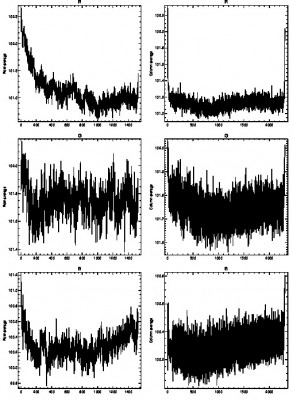We have received help with the software that extracts images from the Sigma SD10 X3F files. These are RAW files packaged in a special way. The software is ‘x3f_extract’, provided at proxel.se by Roland Karlsson. The code can be downloaded at http://proxel.se/x3f.html
A small modification of the code is needed to avoid ‘clipping’ of pixel values below the mean of the bias level. The modification must be introduced into the source file and then code must be recompiled. The code to modify is inside the ‘src’ directory that is built when you download all the source files from proxel. Inside the code ‘x3f_io.c’ go to the routine “huffman_decode_row” and find the line:
uint16_t c[3] = {0,0,0}, c_fix[3];
comment it out and exchange it with:
uint16_t c[3] = {100,100,100}, c_fix[3];
Then go one level up and run ‘make’.
I did the above and took some dark frames that I averaged in the half-median-half-mean way, in each pixel. I generated row and column sums of these dark frames and got this:
The structure is low, actually, at the 1 count level.
With this fix of the x3f_extract code we have no longer a ‘strange clipping’ problem and the SD10 can be used for astrophotography – the point being that when its internal IR filter is removed and a red filter i used over the lens we have in effect a camera able to perform VE1 and VE2 band photometry in one shot, without any moving parts. We have yet to do the image manipulations required to reduce the images obtained in the R G and B channels to R G and IR values – but that will happen.

